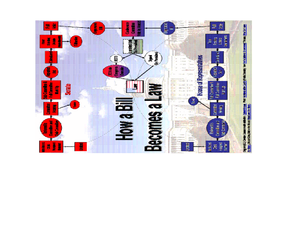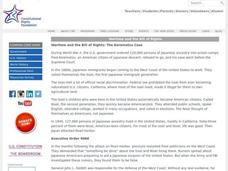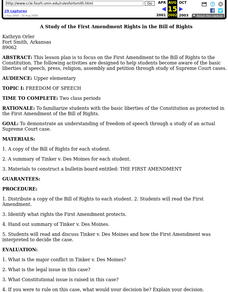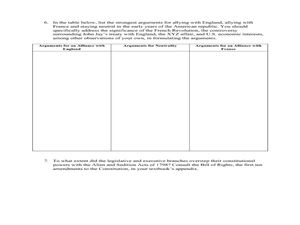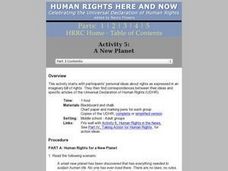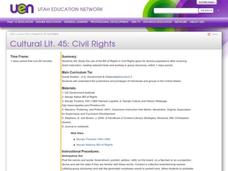Curated OER
Fairy Tails Can Show Due:It can happen for you, If you play your part.,
Learners view a Reader's Theater focusing on the story of Goldilocks and the Three Bears. The story is used as a springboard into a videotaped mock trial of Gold E. Locks developed by the American Board of Trial Advocates (ABOTA). They...
Curated OER
The U.S. Constitution:Continuity and Change in the Governing of the United States
Students interpret historical evidence presented in primary and secondary resources. In this U.S. Constitution lesson, students examine and analyze primary sources regarding the plan for U.S. government.
National Endowment for the Humanities
Magna Carta: Cornerstone of the U.S. Constitution
High schoolers use the Internet to read a brief description of Magna Carta (link provided). They "walk through" the document with the teacher, identifying four major themes. High schoolers read and discuss "The Rhetoric of Rights:...
Curated OER
What is Meant by Returning to Fundamental Principles?
What did the Founding Fathers mean by the importance of continually returning to fundamental principles? Your young historians will analyze a series of quotations illustrating the fundamental ideals and principles of the United States...
James Madison Memorial Fellowship Foundation
Application of the Principles of the Constitution
If you want to challenge your US government class, this assignment requires them to identify a contemporary issue or event that reflects the four main principles of the Constitution (federalism, separation of powers, protection of...
Curated OER
How Government Works and the Rights of the People
Eighth graders identify how to be responsible citizens. In this civics lesson, 8th graders review websites of congressional members and then create questionnaires about the responsibilities of citizens.
Curated OER
Wartime and the Bill of Rights: The Korematsu Case
Students examine the balance between civil liberties and protection. For this national security lesson, students explore the Korematsu case which references the Japanese internment camps of World War II. Students draw comparisons between...
Curated OER
A Study of the First Amendment Rights in the Bill of Rights
Students become aware of the basic liberties of speech, press, religion, assembly and petition through study of Supreme Court cases. Student groups analyae some cases heard by the Supreme Court to further their understanding of the First...
Curated OER
Wartime and the Bill of Rights: The Korematsu Case
Twelfth graders work together in groups to examine the discrimation Japanese Americans felt after the bombing of Pearl Harbor. Using primary source documents, they analyze and discuss the case of Fred Korematsu who was placed in an...
Heritage Foundation
Procedural Amendments: Amendments III, IV, and V
So many US Constitution clauses, so little time. The 17th installment in a 20-part series teaches pupils about the Third, Fourth, and Fifth Amendments. Learning through activities such as group work, connecting to current events, and...
Heritage Foundation
Substantive Amendments: Amendments I and II
The First and Second Amendments remain some of the most famous, even to this day. Learners read about several clauses from the US Constitution through a variety of captivating activities including before and after reading, group work,...
Curated OER
Civil Rights: An Investigation
High schoolers take a closer look at the political side of the American Civil Rights Movement. For this 20th century American history lesson, students research the contributions of President Johnson, Dr. Martin Luther King, Jr., and J....
Curated OER
The Constitution: Drafting a More Perfect Union
Students analyze an unknown primary source document to determine its origin. In this Constitution lesson, students read primary source documents and contrast and compare the evolution of the drafts of the Constitution. Students analyze...
Constitutional Rights Foundation
Naturalized Citizens and the Presidency
Article II, Section 1 of the U.S. Constitution takes center stage in a lesson plan that asks class members to assume the role of state senators, debate a resolution to amend the U. S. Constitution to permit naturalized citizens to run...
National Constitution Center
AP English Language—Argument
All things are subject to interpretation ... and that includes the Bill of Rights. Scholars work through activities to analyze and consider various interpretations and perspectives of the rights listed in the Constitution. They complete...
Curated OER
We Are the Government
Students read primary documents to find the motivations of the founding fathers of the United States. In this primary documents lesson, students discuss the meaning of the Preamble to the Constitution, read parts of the Constitution...
Curated OER
The First Amendment: Freedom of Expression
Learners explore First Amendment rights. In this U.S. Constitution lesson plan, students examine the freedom of expression as they view a PowerPoint presentation and listen to the lecture that accompanies it.
Curated OER
We the People Lesson 2
Students compare the Federalists and Anti-Federalists visions for the U.S. government. In this government lesson, students conduct research on Federalists and Anti-Federalists figures. Students use their findings to help them write...
Curated OER
The American People, “Creating a Nation”
In this early American history worksheet, learners read noted pages in their textbooks and then respond to 7 short answer questions regarding the U.S. Constitution and its formation.
Curated OER
A New Planet
Students, in gorups, develop a Bill of rRghts for a newly discovered planet. They give the planet a name and they decide upon ten human rights they think are the most important. Then they compare their list with the lists of other...
Curated OER
Bill O'Rights
Learners discuss and identify the first ten amendments to the Constitution and apply their understanding of the material to how they currently affect their lives. They discover the rights and responsibilities of being a citizen, and...
Curated OER
Constitution Web-lesson
Learners examine multiple sources like america's founders, court cases, headilnes and more to learn about the Constitutional Convention of 1787
Curated OER
Civil Rights
Students are introduced to the concept of Civil Rights. In groups, they use a timeline of the Navajo tribe to identify the ways the tribe has made advances in Civil Rights throughout the years. To end the lesson, they take notes and...
Curated OER
Are We Free Yet?
Students read excerpts from several Freedom Documents, evaluate amount of freedom guaranteed by each document, and rank documents on scale to determine which grant greatest and least amount of personal freedom.







